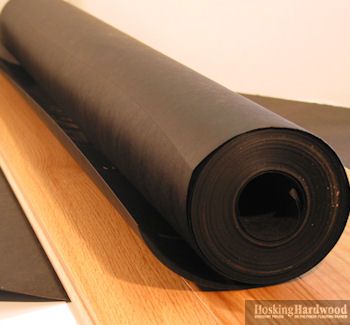Table of Contents:
Introduction
When it comes to installing hardwood flooring, proper underlayment is crucial to ensure durability and longevity. One common concern is whether roofing paper, also known as felt paper or tar paper, can be used as an underlayment for hardwood flooring. In this article, we will explore the benefits and considerations of using roofing paper under hardwood flooring, the installation process, and possible alternatives.
Benefits of Using Roofing Paper
Roofing paper offers several benefits as an underlayment for hardwood flooring:
1. Moisture Barrier: One of the primary benefits of using roofing paper is its ability to act as a moisture barrier. It helps prevent any moisture or vapor from the subfloor from reaching the hardwood flooring, protecting it from potential damage caused by humidity or dampness.
2. Noise Reduction: Roofing paper can also provide some level of sound reduction. It helps minimize the noise produced when walking on the hardwood floor by absorbing and dampening vibrations.
3. Smooth Surface: Using roofing paper creates a smooth and even surface for the installation of hardwood flooring. It helps to eliminate minor imperfections in the subfloor, ensuring a better final result.
4. Added Protection: Roofing paper can offer an extra layer of protection against minor spills or accidents during the flooring installation process. It can help minimize damage caused by spills or moisture during construction.
Considerations when Using Roofing Paper
While roofing paper can be a suitable underlayment option for hardwood flooring, there are a few considerations to keep in mind:
1. Compatibility: Ensure that the roofing paper you choose is compatible with hardwood flooring. Check the manufacturer’s guidelines or consult with the flooring supplier to verify suitability.
2. Thickness and Quality: The thickness and quality of the roofing paper are important factors to consider. Opt for a higher-quality grade roofing paper with sufficient thickness to provide optimal protection and support for your hardwood flooring.
3. Ventilation: Roofing paper may limit moisture flow, so it’s important to ensure proper ventilation in your flooring system. This prevents moisture from being trapped between the subfloor and the hardwood floor, which could lead to mold or mildew issues.
4. Code Compliance: Roofing paper may not be compliant with certain building codes or regulations in some regions. Always check with local authorities or consult a professional to ensure adherence to relevant codes.
Installation Process
To install roofing paper as underlayment for hardwood flooring, follow these general steps:
1. Prepare the Subfloor: Clean and ensure the subfloor is dry, smooth, and free from any debris.
2. Measure and Cut: Measure the dimensions of the room and cut the roofing paper into manageable sections. Leave an overlap of about 2-3 inches between adjoining pieces.
3. Lay the Roofing Paper: Start at one end of the room and roll out the roofing paper over the entire subfloor. Ensure the paper remains flat and wrinkle-free throughout the installation process.
4. Secure the Paper: Use a staple gun or suitable adhesive to secure the roofing paper to the subfloor. Place fasteners approximately every 6-8 inches along the edges and seams to ensure a secure attachment.
5. Trim Excess: Trim any excess roofing paper with a utility knife or scissors, leaving a clean edge along the walls.
6. Proceed with Hardwood Flooring Installation: Once the underlayment is properly installed, you can proceed with the installation of your hardwood flooring according to manufacturer guidelines.
Alternatives to Roofing Paper
While roofing paper can be a viable option, there are alternative underlayment materials available for hardwood flooring installation:
1. Foam Underlayment: Foam underlayment offers excellent noise reduction and moisture resistance. It is available in various thicknesses and can provide a cushioning effect for added comfort.
2. Cork Underlayment: Cork underlayment is an environmentally friendly option that provides soundproofing and insulation properties. It also offers moisture resistance and is suitable for use with hardwood flooring.
3. Plywood Subfloor: In some cases, a plywood subfloor may be sufficient as an underlayment for hardwood flooring. However, additional moisture barriers may be required to reinforce protection against moisture.
Conclusion
In conclusion, roofing paper can be used as an underlayment for hardwood flooring, providing several benefits such as moisture barrier protection, noise reduction, and a smooth surface for installation. However, it is essential to consider compatibility, thickness, ventilation, and code compliance before selecting roofing paper as your underlayment material. Alternatives like foam underlayment, cork underlayment, or plywood subfloors can also be suitable options depending on specific requirements.
Frequently Asked Questions
1. Can I use roofing paper as an underlayment for all types of hardwood flooring?
Roofing paper can be used as an underlayment for most types of hardwood flooring. However, it’s always best to check with the manufacturer or supplier to ensure compatibility with your specific flooring type.
2. How should I secure the roofing paper to the subfloor?
Roofing paper can be secured to the subfloor using a staple gun or appropriate adhesive. Staples or fasteners should be spaced every 6-8 inches along edges and seams to provide proper attachment.
3. Can roofing paper completely protect hardwood flooring from moisture?
While roofing paper acts as a moisture barrier, it is not a foolproof solution. It helps prevent moisture from reaching the hardwood flooring but cannot provide complete protection in case of significant water spills or flooding. Promptly clean up any spills to maintain the integrity of the hardwood floor.
4. Are there any alternatives to roofing paper for underlayment?
Yes, there are alternative underlayment materials available, such as foam underlayment, cork underlayment, or plywood subfloors. These options provide different benefits and may suit specific requirements better.
5. Is it necessary to consult a professional for underlayment installation?
While it is possible to perform underlayment installation as a DIY project, consulting a professional is advisable, especially if you are unsure about any aspect of the installation process. Professionals can provide expert guidance, ensuring proper installation and compatibility with your chosen hardwood flooring.
nnn.ng
https://nnn.ng/faq/28593/












